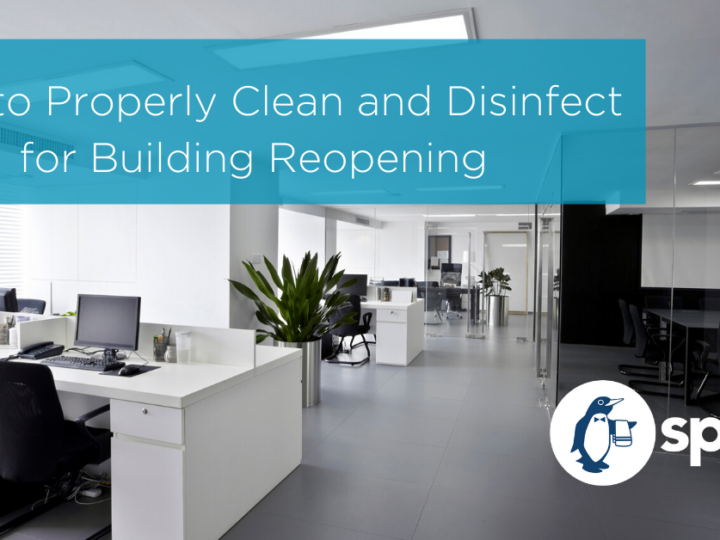Key Guidelines for Building Reopening
As buildings across the country prepare to reopen and ramp up their capacity, there’s plenty of concern over how safe they are for regular activity. Employees of all types are rightfully concerned about their health and wellbeing, which puts pressure on facility managers to clean their buildings responsibly. And without the right strategy in place, you can quickly risk a spike in COVID-19 infections.
While you’re following the guidelines to reopen your building, the best way to minimize risk is with a disinfection action plan.
Understanding the Proper Cleaning and Disinfection Protocols
The COVID-19 pandemic has put a significant emphasis on disinfection, which is a part of your building’s biosecurity. Though it seems like a new area of focus, your facility already has at least one of these practices in place: requiring employees to wash their hands after using the restroom.
However, the proper cleaning and disinfection protocols extend further beyond this simple step. There are four steps to achieve complete disinfection: pre-cleaning, disinfecting, wiping clean, and rinsing with water. It’s crucial to know the difference between the two. Disinfection can’t work effectively without a dedication to cleaning off the organic and inorganic materials that can gather on surfaces.
Typical disinfection products, such as Clorox or Lysol, can cut this protocol in half and stop after the second step. Unfortunately, these products continue to be in short supply across the country. This has pushed consumers and businesses to rely on DIY solutions, such as bleach mixed with water, which run the risk of losing effectiveness as the scale increases. When it comes to warehouses with large numbers of employees, the small-scale solutions can’t routinely disinfect surfaces fast enough without significant use of labor.
Identify Your Weaknesses
With a greater understanding of the importance of cleaning and disinfection, you can begin highlighting the weaknesses of your building. You might manage a small office, a large warehouse, or anything else in between. There are several different solutions for various types of spaces, which require a keen understanding of your facility.
The conventional approach for facilities is to rely on chlorine dioxide gas, an effective water-activated dispersal method for shared spaces. While our knowledge about the impacts of aerosolized gas as disinfectants is expanding, there’s recent evidence to support regular use for your facility. A 2017 study from Frontiers in Microbiology found that “fogging with disinfectants containing chlorine dioxide and hydrogen peroxide—chemicals commonly used in commercial applications—was able to inactivate viruses studied and get to hard-to-reach places.”
A current trend, made more popular by COVID-19, is the use of antimicrobial protection in facilities. These products are applied in two-phases via a hand-held mister. The process starts by destroying contaminants before applying a protective layer that inhibits the growth of microorganisms for up to 3 months.
Creating Your Disinfection Action Plan
By understanding the needs and weaknesses of your building, you can adequately address them with the right disinfection products. At Spiffy, we rely on hospital-grade chemicals that provide clients with powerful results that don’t cause damage or corrosion. While each facility comes with a slightly different process, every service is conducted by following CDC guidelines for high-touch surfaces and common spaces alike.
Not only is it important to routinely clean high-traffic areas, particularly if you have a lot of employee or customer movement, but the disinfection process needs to be appropriately conducted to minimize contamination. This includes the following:
- Proper training for the use of disinfectants
- Wearing gloves and gowns throughout the process
- Responsibly utilizing personal protective equipment based on each cleaning scenario
- Carefully removing and disposing of used protective equipment
- Washing hands with soap and water for 20 seconds, immediately after removing equipment
- Keeping hand sanitizer with at least 60% alcohol nearby
By following these protocols, you and your building’s tenants can lay concerns to rest and focus on reopening the right way. If you are interested in properly cleaning and disinfecting your facility, don’t hesitate to learn about our disinfection services today. Our partnership with qlair is ready to provide you with the perfect workplace reopening package for your needs.
Expert Help for Navigating Building Reopening Guidelines
Our team at qlair has partnered with a leader in cleaning and disinfectant – Spiffy – to provide an end-to-end solution to building reopening. We have developed a five–phase process that will:
- Establish a healthy baseline for your indoor environment prior to reopening
- Prepare your building with rigorous cleaning and disinfecting
- Enable your building to provide a continuously clean and safe environment for your occupants
For more information on our Workplace Preparation Package, please visit: https://i-qlair.com/workplace-reopening-packages/
Jackson Balling
Jackson is Spiffy’s Content Marketing Manager, bringing over five years of professional experience in creative copywriting, audio production, and video editing to their Marketing team.


